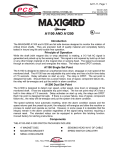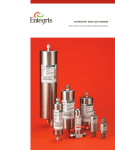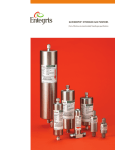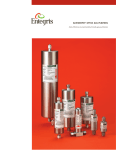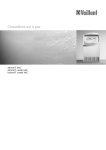Download A1000 Installation Instructions
Transcript
A102-05, Page 1 PCS PROCESS CONTROL SYSTEMS 952-361-3026 (Fax) 952-368-4129 TM PROCESS CONTROL SYSTEMS, INC. 327 LAKE HAZELTINE DRIVE, CHASKA, MN 55318 800-328-0738 TM MAXIGARD A1000 SPEED SWITCH Introduction The Maxigard A1000 speed switch is designed to monitor the rotation of critical driven shafts. The switch is precision built of quality material and completely factory tested to insure long life and trouble free operation. Principle of Operation The Maxigard A1000 speed switch is supplied with a non-contacting sensor and magnetic target. The sensor signal is not impaired by buildup of dust or any other foreign material on the magnet disc or sensor. This switch is designed to detect under speed or over speed of the monitored shaft. The A1000 has one adjustable set point and a built in power-up time delay of approximately 7 seconds which allows machinery controlled through the motor starter circuit to reach the set point during start-up. The delay activates on power-up only and can be disabled with a field selectable jumper pin configuration. When properly installed and calibrated, in the event of a power failure or loss of sensor signal the relay will de-energize and put the switch into an alarm condition. Components THE A1000 SPEED SWITCH INCLUDES: z 4“ MAGNET DISC (OTHER OPTIONAL MAGNETIC TARGETS AVAILABLE) z SENSOR WITH 10’ OF CABLE AND MOUNTING BRACKET z A1000 SPEED SWITCH CIRCUIT BOARDS WITH 10 AMP RELAY z NEMA 4 ENCLOSURE CALL TOLL FREE PCS TM PROCESS CONTROL SYSTEMS 800-328-0738 www.maxigard.com E-mail: [email protected] A102-05, Page 2 SECTION 1 - MECHANICAL 1.0 Magnet Disc 1.1 The end of the shaft to be monitored should be square to prevent excessive disc wobble. 1.2 Center drill and tap the shaft end. (Suggested #21 drill and #10-32NF tap). Bolt the magnet disc to the end of the shaft. Use “Loc-tite” to keep the bolt and disc tight on the shaft. (see figure 1A &1C, page 3). 2.0 Magnet Wrap (optional) 2.1 Separate the two halves of the magnet wrap by loosening the cap screws holding the two halves together. 2.2 Place both halves of the magnet wrap around the shaft. Re-insert and tighten the cap screws making sure the wrap is square to the shaft. (see figure 1B & 1D, page 3). NOTE There will be a slight gap between the two halves after tightening. This gap will not affect the generated signal. 3.0 Mounting the Sensor 3.1 Place the sensor so it is centered directly in front of the magnets in the disc or optional wrap. (see figure 1A, 1B, 1C & 1D, page 3). 3.2 The gap setting between the sensor and magnet disc should be approximately 1/8” - 7/8”. CALL TOLL FREE PCS TM PROCESS CONTROL SYSTEMS 800-328-0738 www.maxigard.com E-mail: [email protected] A102-05, Page 3 SENSING METHOD STANDARD SENSING HEAD & MAGNETIC DISC STANDARD SENSING HEAD & MAGNETIC WRAP 1/8" to 7/8" GAP SENSOR MAGNET 1/8" to 7/8" GAP MAGNET SENSOR MAGNET WRAP MAGNET DISC Figure 1A Figure 1B XP SENSING HEAD & MAGNETIC DISC XP SENSING HEAD & MAGNETIC WRAP 1/8" to 7/8" GAP MAGNET 1/8" to 7/8" GAP MAGNET 1 5/8" Figure 1C Figure 1D DIMENSIONAL DATA 1/4" 1 1/2" 1 1/2" 4" 10’ 5/16" 5/16" 2 1/2" 10’ 1 1/2" 1 1/2" 3/4" 2" 1 3/8" 3/4" 1/2" NPS 3/16" MATERIAL: RED ANODIZED ALUMINUM 1/2" NPS 2" 1 3/8" STANDARD SENSING HEAD AND MOUNTING BRACKET STANDARD MAGNET DISC 2 1/2" MATERIAL: PVC NEMA 4X SENSING HEAD AND MOUNTING BRACKET 3" 1 1/2" 1 1/2" 15/16" 1 1/2" 2" D"+3" 5/8" 5/8" 5/16" X 1" 1" 2 1/2" 4" D" 7/8" 10’ OPTIONAL MAGNET WRAP XP SENSING HEAD AND MOUNTING BRACKET Figure 2 PCS PROCESS CONTROL SYSTEMS TM CALL TOLL FREE 800-328-0738 www.maxigard.com E-mail: [email protected] A102-05, Page 4 4.0 Speed Switch Enclosure 4.1 A1000 enclosures are UL / CSA listed, rated NEMA 4, dust tight, oil tight and water tight painted carbon steel construction suitable for indoor and outdoor use. NEMA 4X fiberglass or stainless steel available. (see figure 3A & 3B, page 4) CAUTION Remove the circuit board from the enclosure before punching or drilling conduit holes. Be sure to remove all metal chips and filings. NEMA 4 PAINTED CARBON STEEL OR NEMA 4X STAINLESS STEEL NEMA 4X FIBERGLASS 6 1/2" 4 1/4" 4" 6" 4" 4" 4" 6 1/2" 6 3/4" 7 1/8" NOTE: NEMA 4X STAINLESS STEEL ENCLOSURE DOES NOT INCLUDE SIDE CLAMPS. Figure 3B Figure 3A CALL TOLL FREE PCS TM PROCESS CONTROL SYSTEMS 800-328-0738 www.maxigard.com E-mail: [email protected] A102-05, Page 5 SECTION 2 - FIELD WIRING 5.0 Sensor Wiring 5.1 Connect the sensor cable to terminals black, white and shield located on the terminal block TB1. (see figure 4, page 6) 5.2 The sensor comes standard with 10’ of cable. Additional cable can be added as required. Be sure to maintain continuity. Wrap the splice with the foil shield and electrical tape. SENSING HEAD CABLE Use “Belden” #8761 or equal. Cable should not be run in same conduit as power wires. Maximum distance of cable run 10,000 ft. Make good splice connections and check continuity. 6.0 Wiring the A1000 Speed Switch WARNING To avoid electrical shock disconnect all sources of power to the motor starter before wiring and observe voltage ratings of the speed switch. 6.1 Power connections and relay connections to the A1000 speed switch are shown on figure 4, page 6. Also, figures 5, 6 and 7 show typical wiring diagrams. 6.2 Connect 120 VAC power to L1 and neutral to L2 on terminal block TB2 (see figure 4, page 6). See figures 5, 6 and 7 for examples of typical wiring diagrams. Connect equipment safety ground to GRD on terminal block TB2. 6.3 Make relay connections to terminal block TB2. Normally open contacts are held closed and the normally closed contacts are held open when the shaft speed exceeds the calibrated set point. CALL TOLL FREE PCS TM PROCESS CONTROL SYSTEMS 800-328-0738 www.maxigard.com E-mail: [email protected] A102-05, Page 6 4 7/8" 4 1/4" TB2 120VAC POWER CONNECTION TACH CALIBRATION GRD L2 P3 TB1 L1 SHLD C SET POINT RELAY CONTACTS SLIDE SWITCH 1 NO 2 SET POINT P1 TP OP + 4 SENSING HEAD CONNECTION WHT - NC 3 C BLK 4 7/8" OPTIONAL TACH OUTPUT NO 5 SPEED RANGE SELECTION DIP SWITCH SW1 NC 6 PN 1325 CIRCUIT BOARD PN 1315 CIRCUIT BOARD Figure 4 CALL TOLL FREE PCS TM PROCESS CONTROL SYSTEMS 800-328-0738 www.maxigard.com E-mail: [email protected] A102-05, Page 7 TYPICAL WIRING TO MOTOR STARTER TYPICAL WIRING TO MOTOR STARTER 120VAC N A1000 L1 L2 GND STOP START OL’s M M 1 2 N.O. COM N.O. AUX 3 N.C. 4 5 N.O. COM 6 N.C. Figure 5 When the start pushbutton is pressed the A1000 speed switch is powered on and a “power on” delay of approximately 7 seconds begins. During the “power on” delay the relay contacts are held in the switched position allowing the motor to run. As long as the monitored shaft is above the set point speed before the “power on” delay period has expired, the relay contacts will remain in the switched position allowing the monitored machine to run normally. If the monitored shaft speed slows down or stops below the set point speed the N.O. relay contact holding in the motor starter contact will open and drop out the motor starter. The “power on” delay is reset when the motor starter drops out and power is interrupted to the A1000. The “power on” delay can be disabled by reconfiguring the time delay jumper pins. (see figure 8, page 10) An additional contact is available to sound an alarm horn, turn on another type of warning device, or interlock with other equipment. CALL TOLL FREE PCS TM PROCESS CONTROL SYSTEMS 800-328-0738 www.maxigard.com E-mail: [email protected] A102-05, Page 8 TYPICAL WIRING TO MOTOR STARTER 120VAC N A1000 L1 L2 GND STOP START OL’s M M 2 1 N.O. COM N.O. AUX 3 N.C. 4 5 N.O. COM 6 N.C. Figure 6 When 120 VAC is applied to L1 and L2 the A1000 speed switch is powered on and a “power on” delay of approximately 7 seconds begins. During the “power on” delay the relay contacts are held in the switched position allowing the motor to run. As long as the monitored shaft is above the set point speed before the “power on” delay period has expired, the relay contacts will remain in the switched position allowing the monitored machine to run normally. If the monitored shaft speed slows down or stops below the set point speed the N.O. relay contact holding the motor starter contact will open and drop out the motor starter. The “power on” delay is reset when power is removed from L1 and L2. If the A1000 is powered continuously the “power on” delay only occurs at initial power up and is not available for later restarts. If continuously powered the start pushbutton will need to be held closed until the monitored shaft reaches operating speed allowing the motor starter to seal through the motion switch contact. The “power on” delay can be disabled by reconfiguring the time delay jumper pins. (see figure 8, page 10) An additional contact is available to sound an alarm horn, turn on another type of warning device, or interlock with other equipment. CALL TOLL FREE PCS TM PROCESS CONTROL SYSTEMS 800-328-0738 www.maxigard.com E-mail: [email protected] A102-05, Page 9 TYPICAL WIRING TO PLC OR CONTROL RELAY 120VAC N A1000 L1 L2 GND PLC Input Module - 120VAC I:001/01 I:001/02 1 COM 2 N.O. I:001/03 I:001/04 3 N.C. 4 COM 5 N.O. CR 6 N.C. Figure 7 When 120 VAC is applied to L1 and L2 the A1000 speed switch is powered on and a “power on” delay of approximately 7 seconds begins. During the “power on” delay the relay contacts are held in the switched position allowing the motor to run. As long as the monitored shaft is above the set point speed before the “power on” delay period has expired, the relay contacts will remain in the switched position. If the monitored shaft speed stops or slows down below the set point speed the N.O. relay contacts open. When the monitored shaft speed exceeds the set point the N.O. relay contacts close. The “power on” delay is reset when power is removed from L1 and L2. If the A1000 is continuously powered the “power on” delay only occurs at initial power up. The “power on” delay can be disabled by reconfiguring the time delay jumper pins. (see figure 8, page 10) CALL TOLL FREE PCS TM PROCESS CONTROL SYSTEMS 800-328-0738 www.maxigard.com E-mail: [email protected] A102-05, Page 10 SECTION 3 - CALIBRATION 7.0 A1000 Speed Switch Calibration 7.1 Set the A1000 dip switches for the proper speed range based on the normal operating speed of the monitored shaft. (see figure 8, page 10) SW1 ON POT P1 SETPOINT ADJUSTMENT 1 2 3 DIP SWITCH TIME DELAY JUMPERS TIME DELAY JUMPER SETTINGS ENABLED POT P3 TACHOMETER CALIBRATION (OPERATING SPEED) DISABLED ON ON 1 2 3 0 to 250 RPM ON ON 1 2 3 1 2 3 1 2 3 250 to 600 RPM 600 to 800 RPM 800 to 3000 RPM ON 1 2 3 3000 to 5000+ RPM Figure 8 8.0 A1000 Start Delay Configuration 8.1 The A1000 can be configured with or without a 7 second start delay. With the start delay feature enabled the A1000 relay will automatically energize for 7 seconds upon power-up. This feature is used to allow the monitored shaft to reach the set point speed during start up without causing an alarm condition. If the shaft has not reached the set point speed before the 7 second start delay period has expired, then the A1000 switch will go into an alarm condition. With the start delay feature disabled the A1000 relay will not energize until the monitored shaft speed exceeds the calibrated set point. (see figure 8, page 10) CALL TOLL FREE PCS TM PROCESS CONTROL SYSTEMS 800-328-0738 www.maxigard.com E-mail: [email protected] A102-05, Page 11 9.0 Calibration with Voltmeter If the optional tachometer is not supplied with the A1000, a voltmeter can be used to calibrate the speed switch. Connect the voltmeter leads to terminal block TB1 optional tach output connections (+) and (-). (see figure 9, page 12) 9.1 To calibrate the operating speed place the slide switch in the operating speed position (OP). With the machine running at normal operating speed adjust potentiometer P3 (CCW to increase/CW to decrease) until the voltmeter reads the recommended DC voltage as shown on table 1. Table 1 9.2 To calibrate the set point place the slide switch in the set point position (TP). Calculate the set point value by taking a percentage of the operating speed tach output voltage from table 1. Adjust potentiometer P1 until you reach the desired set point on the voltmeter (CW to increase/CCW to decrease). The machine does not need to be running to make this adjustment. (see figure 9, page 12) EXAMPLE If the operating speed of the monitored shaft is 300 RPM set P3 for a voltmeter reading of 1.00 VDC while the machine is running at 100%. For an 80% set point (240 RPM) set P1 for a voltmeter reading of .80 VDC. (1.00 VDC x 80% = .80 VDC) (see table 1) CALL TOLL FREE PCS TM PROCESS CONTROL SYSTEMS 800-328-0738 www.maxigard.com E-mail: [email protected] A102-05, Page 12 9.3 Return the slide switch to the OP position. The meter will now display the operating voltage. The set point will still function properly if the slide switch SW1 is in the TP position. (see figure 9, page 12) 9.4 A1000 speed switch is now calibrated. 10.0 Calibration with Optional Tachometer If the optional tachometer is supplied with the A1000, connect the meter as shown in figure 9, page 12. 10.1 To calibrate the operating speed place the slide switch in the operating speed position (OP). With the machine running at normal operating speed adjust potentiometer P3 until the display meter reads 100% (CCW to increase/CW to decrease). (see figure 9, page 12) 10.2 To calibrate the set point place the slide switch in the set point position (TP). Adjust potentiometer P1 until you reach the desired set point on the display meter (CW to increase/CCW to decrease). The machine does not need to be running to make this adjustment. (see figure 9, page 12) 10.3 Return the slide switch to the OP position. The meter will now display the operating speed. The set point will still function properly if the slide switch SW1 is in the TP position. (see figure 9, page 12) 10.4 The A1000 speed switch is now calibrated. TB2 TACH CALIBRATION GRD L2 P3 OPTIONAL TACHOMETER TB1 L1 SHLD C SLIDE SWITCH 1 NO 2 TP SET POINT P1 NC 6 0 WHT 100 OP + 4 NO 5 SENSING HEAD CONNECTION - NC 3 C BLK RELAY SPEED RANGE SELECTION DIP SWITCH SW1 % RPM OPTIONAL TACH OUTPUT POT P1 CW = INCREASE CCW = DECREASE POT P3 CCW = INCREASE CW = DECREASE Figure 9 PCS PROCESS CONTROL SYSTEMS TM CALL TOLL FREE 800-328-0738 www.maxigard.com E-mail: [email protected] A102-05, Page 13 SPARE PARTS LIST Part No. Description 1315 1325 1129 1130 1132 1134 1136 1320 A1000 Power Supply Circuit Board Without Relay Low Set Point Circuit Board Standard Sensor With 10’ Cable Mounting Bracket With Jam Nuts Explosion Proof Sensor With 10’ Cable Mounting Bracket 4” Magnet Disc Relay DPDT - 10 AMP @ 120 VAC LIMITED WARRANTY Process Control Systems, Inc. will repair or replace, at their option, F.O.B. factory, any part or unit which proves to be defective in material or workmanship within five years of purchase date, provided that part of the unit was installed and operated as recommended, to be established by examination of the part or unit at the factory. Goods returned under warranty must be shipped prepaid to the factory and accompanied by the serial number, description of defect, order number and date of purchase. This warranty shall not apply to any Maxigard TM product which shall have been repaired or altered outside of the Process Control Systems factory or has been subject to misuse, negligence or accident. Process Control Systems, Inc. warrants its products, but not their application, and shall not be liable for any incidental or consequential damages incurred through the use or loss of use of a Process Control Systems product. No representatives or other person is authorized or permitted to make any warranty or assume for this company any liability not strictly in accordance with this guarantee. There is no further warranty either expressed or implied beyond that set forth herein. CALL TOLL FREE PCS TM PROCESS CONTROL SYSTEMS 800-328-0738 www.maxigard.com E-mail: [email protected]













